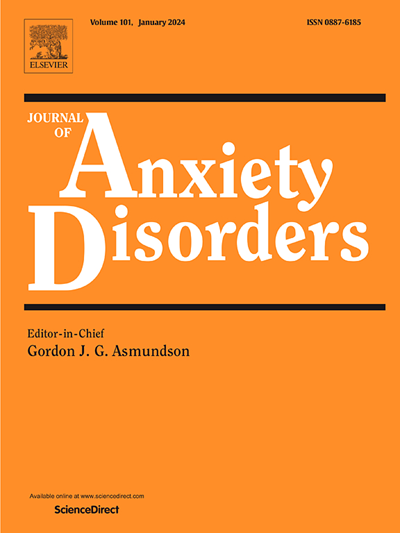FOMO’s apprehension of missing out and constant connection desire dimensions differentially correlate with problematic smartphone and social media use, but not with depression or generalized anxiety
IF 4.5
2区 医学
Q1 PSYCHIATRY
引用次数: 0
Abstract
The fear of missing out (FOMO) involves an apprehension of missing out on rewarding experiences, and a desire to continually stay connected with people. However, this two-dimension conceptualization of FOMO has not been properly empirically examined. We examined this two-factor model using confirmatory factor analysis in 326 American college students, and 433 Italian participants recruited through social media. We discovered that in both samples, the two-factor model fit well; e.g., the US sample’s comparative fit index (CFI) = .990, Tucker-Lewis Index (TLI) = .985; Italian sample’s CFI = .941, TLI = .917. The two-factor model fit significantly better than a one-factor model in both samples (ps<.001) (though magnitude of differences was small, with CFI differences ranging from .001–.007). In both samples, problematic social media use severity was more correlated (ps<.001) with FOMO’s constant connection desire factor (US sample r = .749; Italian sample r = .845) than apprehension of missing out factor (US sample r = .622; Italian sample r = .500). In the American sample, problematic smartphone use severity also correlated more (p < .001) with constant connection desire (r = .668) than apprehension of missing out (r = .587). However, in the American sample depression severity correlated equally (ps>.05) with FOMO’s constant connection desire (r = .466) and apprehension of missing out (r = .503) factors; generalized anxiety disorder symptoms also equally correlated (ps>.05) with FOMO’s constant connection desire (r = .470) and apprehension of missing out (r = .508). We discuss implications of our findings for measurement of FOMO, and FOMO’s relationship with problematic Internet use and negative affectivity.
FOMO对错过和持续联系欲望维度的担忧与智能手机和社交媒体的问题使用存在差异,但与抑郁或广泛性焦虑无关
错失恐惧(FOMO)包括对错过有益经历的担忧,以及与人保持联系的渴望。然而,这种FOMO的二维概念化尚未得到适当的实证检验。我们使用验证性因子分析对326名美国大学生和433名通过社交媒体招募的意大利参与者进行了检验。我们发现,在两个样本中,双因素模型拟合良好;例如,美国样本的比较拟合指数(CFI) = 。990, Tucker-Lewis指数(TLI) = .985;意大利样品的CFI = 。941, tli = .917。在两个样本中,双因素模型的拟合效果明显优于单因素模型(ps<.001)(尽管差异幅度很小,CFI差异范围为0.001 - 0.007)。在两个样本中,有问题的社交媒体使用严重程度与FOMO的恒定连接欲望因子(美国样本r = .749;意大利样本r = .845)大于对遗漏因子的理解(美国样本r = .622;意大利样本r = .500)。在美国的样本中,有问题的智能手机使用严重程度与持续的连接欲望(r = .668)的相关性(p <; .001)也高于对错过的担忧(r = .587)。然而,在美国样本中,抑郁严重程度与FOMO的持续连接欲望(r = .466)和错过恐惧(r = .503)因素同等相关(ps> 0.05);广泛性焦虑障碍症状与FOMO的持续联系欲望(r = .470)和对错过的恐惧(r = .508)也同样相关(ps> 0.05)。我们讨论了我们的研究结果对FOMO测量的影响,以及FOMO与有问题的互联网使用和消极情感的关系。
本文章由计算机程序翻译,如有差异,请以英文原文为准。
求助全文
约1分钟内获得全文
求助全文
来源期刊

Journal of Anxiety Disorders
Multiple-
CiteScore
16.60
自引率
2.90%
发文量
95
期刊介绍:
The Journal of Anxiety Disorders is an interdisciplinary journal that publishes research papers on all aspects of anxiety disorders for individuals of all age groups, including children, adolescents, adults, and the elderly. Manuscripts that focus on disorders previously classified as anxiety disorders such as obsessive-compulsive disorder and posttraumatic stress disorder, as well as the new category of illness anxiety disorder, are also within the scope of the journal. The research areas of focus include traditional, behavioral, cognitive, and biological assessment; diagnosis and classification; psychosocial and psychopharmacological treatment; genetics; epidemiology; and prevention. The journal welcomes theoretical and review articles that significantly contribute to current knowledge in the field. It is abstracted and indexed in various databases such as Elsevier, BIOBASE, PubMed/Medline, PsycINFO, BIOSIS Citation Index, BRS Data, Current Contents - Social & Behavioral Sciences, Pascal Francis, Scopus, and Google Scholar.
 求助内容:
求助内容: 应助结果提醒方式:
应助结果提醒方式:


